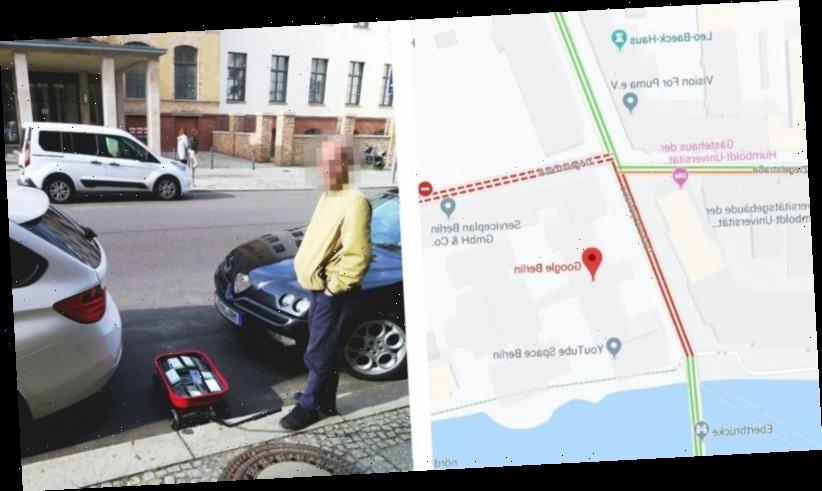The streets were shaded the dreaded dark red on Google Maps, warning drivers of a traffic nightmare. In reality, though, almost no one was on the road; except for a lone man pulling a little red wagon packed with 99 smartphones.
Apps such as Google Maps provide real-time traffic data through crowdsourcing, monitoring the location and speed of phones travelling along on a roadway. The assumption, as noted by Ars Technica, is that the phones are there because they're being carried by drivers inside cars. Usually, a bunch of slow-moving phones could be safely interpreted to mean gridlock.
To Google Maps, a wagon load of navigating smartphones looks the same as a lot of slowly moving cars.Credit:SimonWeckert.com
But in this case, the traffic jam was apparently the work of Simon Weckert, a Berlin-based artist. He calls it “Google Maps Hacks”; performance art meant to demonstrate the pervasive, real-life influence of modern technology.
"People are trying to think about, and start to talk about, what does it mean to use those services in everyday life?" Weckert, 30, says. "And how they shape our everyday life and how, more generally, they shape our everyday society."
Google Maps, Apple Maps and Waze have done their share of shaping society since coming to smartphones in the early 2000s. In trying to help drivers get around faster, they've transformed once-quiet residential streets into bustling cut-through routes. They also may have made overall traffic worse, burdening some routes with congestion they weren't built to support, some researchers say.
Weckert got the idea for his performance after going to a May Day demonstration in Berlin and noticing that Google Maps portrayed the gathering of people as a traffic jam.
As the wagon moved through streets, the turned red on Google Maps, indicating a traffic jam to be avoided.Credit:SimonWeckert.com
He decided to replicate the anomaly himself, he said, borrowing 99 phones from friends and suppliers online. Ninety-nine, of course, because of the Jay-Z song.
"It's basically 99 problems for Uber," Weckert says. "Or, let's say, 99 problems for technology services."
An assistant wandered the streets of Berlin with the wagon in tow, smartphones piled inside. As he made his way down a given street, according to a video Weckert shared on his website, it would go from green to orange to red on Google Maps. All the while, the streets were mostly empty.
It was a striking contrast, Weckert says. "The guy with the handcart with 99 smartphones in it trying to fight against, trying to interrupt, a system run by a huge tech giant."
In a statement responding to questions about the stunt, Google spokeswoman Ivy Hunt noted that traffic data is "refreshed continuously" from multiple sources; including phones that have location services turned on.
"We've launched the ability to distinguish between cars and motorcycles in several countries including India, Indonesia and Egypt, though we haven't quite cracked travelling by wagon," she wrote. "We appreciate seeing creative uses of Google Maps like this as it helps us make maps work better over time."
On his website, Weckert noted that the app has "fundamentally changed our understanding of what a map is, how we interact with maps, their technological limitations and how they look aesthetically." In this way, he wrote, they "make virtual changes to the real city."
He said "Google Maps Hacks" is meant to raise questions about the level of trust people have put in technology, as well as the ways society has adapted to it. The project has indeed drawn attention: Weckert's tweet sharing his work garnered more than 15,000 retweets and almost 35,000 likes, a mix of scepticism, irritation and praise. It's resonating with people for a reason, he said.
"I would say it's related to like the time we are living in right now," he said, "talking about the technological revolution and the influence of each of these tools."
The Washington Post
Source: Read Full Article


